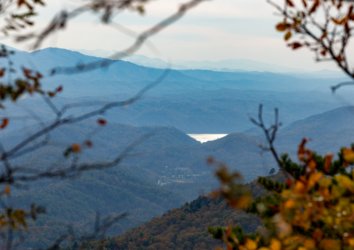While much of Great Smoky Mountains National Park is roadless—and thus a paradise for hikers, backpackers, and all-around wilderness lovers—you’ll also find close to 400 miles of roads that show off some of the standout scenery, history, and ecology of this incredible Appalachian landscape. Auto touring is definitely a viable (and extremely popular) way to experience the Smokies.
Indeed, if you only have a single day in the Great Smokies, a scenic drive is the best option for getting a broad sample of the park’s magic. (Another approach is focusing on a representative day hike, a more zoomed-in and immersive experience. Both strategies are great in their own way.)
In this post, we’ll sketch out the basics of Great Smoky Mountains National Park auto touring, then profile two prime options for day drives!
Soaking Up the Smokies From Behind the Wheel
The 384-some miles of road in Great Smoky Mountains National Park are primarily paved, though there are well-maintained gravel routes as well such as the Greenbrier and Rich Mountain roads well worth checking out as well (and usually just fine for passenger cars to tackle). Secondary roads seasonally close in the winter, but the Newfound Gap Road/US-441 (the only road in the park crossing the Smoky Mountain divide), the Little River Road, and the Caves Cove Loop stay open year-round. (Keep in mind winter weather conditions may result in temporary closures of these otherwise all-season routes.)
Roads provide access to many corners of the park, but the ruggedness of the range means some are “cherry-stem” roads dead-ending in the park and not linking to other park roads. That includes the road into the Cataloochee Valley as well as Lakeview Drive—aka, the famous “Road to Nowhere” on the north shore of Fontana Lake.
All things considered, the best choices for auto touring in the park are those routes with self-guided interpretive booklets: Newfound Gap Road, the Cades Cove Loop Road, the Cataloochee Valley Road, the Roaring Fork Motor Nature Trail, and Upper Tremont Road. Those booklets are available at visitor centers, at the starts of the drives via dispensers, and online.
All the roads in the Great Smokies—paved and unpaved, continuous or cherry-stem—have their charms, but for the most bang for your buck in a day, we especially recommend the Newfound Gap Road and the Cades Cove Loop.
The Newfound Gap Road

The 33-mile-long Newfound Gap Road crosses the lowest mountain pass in the park accessible by vehicle: Newfound Gap itself notched at 5,046 feet along the Smoky Mountain divide. The gap gets its name because it was the “newfound” preferred pass over the crest when, in 1872, geographer Arnold Henry Guyot confirmed through barometric measurements that it was lower than Indian Gap about 1.5 miles to the west, through which the original trans-mountain road went.
The road links the Gatlinburg, Tennessee and Cherokee, North Carolina entrances to Great Smoky Mountains National Park via the Little Pigeon and Oconaluftee drainages, respectively, and from either of those communities, you’ll drive up some 3,000 miles to reach the pass. From the perspectives of microclimate and ecology, such a route is roughly similar to driving from Georgia to Maine: You’ll rise from broadleaf-dominated cove forests at the low ends to the conifer stands of the Smoky Mountain divide, which aren’t all that different from boreal spruce-fir forests in Canada.
Keep in mind that same climatic variation means it’s often 10 to 15 degrees cooler up at Newfound Gap than in Gatlinburg or Cherokee; even in summer, it’s a good idea to pack a sweater or jacket for stops at the higher elevations. In winter, you may run into snow up here; the road closes (temporarily) on occasion during that season.
Newfound Gap itself, which is at the rough midpoint of Newfound Gap Road at Milepost 14.7 and lies right on the Tennessee/North Carolina border, includes one of the major cultural landmarks of the park: the Rockefeller Memorial, which marks the spot where President Franklin D. Roosevelt formally dedicated Great Smoky Mountains National Park in 1940.
Along with that classic photo op, you’ll have some beautiful and far-reaching views from Newfound Gap; sunrises and sunsets here, incidentally, are homerun quality. Another iconic view along the Newfound Gap Road is Chimney Tops Overlook between mileposts 4 and 5, which offers a great look at the famous bedrock crags of the Chimney Tops.
The best views of all await on a must-see detour: the seven-mile-long Clingmans Dome Road, which leads to the high point of the Great Smokies, 6,643-foot Clingmans Dome. Though this road is closed in winter, it’s a popular snow-hiking, snowshoeing, and cross-country skiing route as long as Newfound Gap Road isn’t temporarily closed due to wintry weather.
History buffs will definitely want to make a stop at the Mountain Farm Museum—host to a bunch of 19th-century buildings that were moved here—and the Mingus Mill, a working 1886 grist mill, both close to the Oconaluftee Visitor Center.
There are two picnic areas along the Newfound Gap Road: Chimneys on the Tennessee side, which has nearly 70 sites, and Collins Creek on the North Carolina side, which has 182 sites as well as a reservable pavilion—great spots for lunch on your day trip!
The Cades Cove Loop

Reached via the Little River and Laurel Creek roads, the Cades Cove Loop is an 11-mile tour of one of the most famous natural and cultural landmarks in the park. The great mountain basin of Cades Cove is swoon-worthy beautiful and includes a fantastic collection of historic structures dating from the long-standing pioneer community here. From the John Oliver Cabin and the Cable Mill to the Tipton Place and the Primitive Baptist Church, get the details on the Cades Cove Loop’s venerable landmarks in this blogpost.
The 19th- and early-20th-century structures of Cades Cove would be reason enough to drive the Loop, but this also happens to be (along with, arguably, the Cataloochee Valley) the single most productive wildlife-watching destination in the park. It’s a rare circuit of the Cades Cove Loop that doesn’t include plentiful looks at grazing white-tailed deer and strutting bands of wild turkey, and meanwhile it’s not uncommon to spot coyotes and black bears in the fields as well.
In October, the Cades Cove Loop makes one of the prime “leaf-peeping” drives in the Great Smokies, but even outside that multicolored season, the scenic spread from groves and meadows to looming mountain peaks is reliably postcard-perfect.
About midway through the Cades Cove Loop is the Cades Cove Visitor Center, a year-round interpretive stop that’s only closed on Christmas. You’ve also got a number of trails heading along the Loop, including such short routes as the Cades Cove Nature Trail and Abrams Falls that can easily be woven into a day trip drive.
Soak Up Great Smokies Scenery on a Day Drive Through the Park
From the evocative vintage cabins and milling deer of Cades Cove to the long views from Newfound Gap Road up on the Smokies backbone, a day drive in Great Smoky Mountains National Park is a great way to get a feel for this special place—and get inspired for a longer follow-up visit soon!




